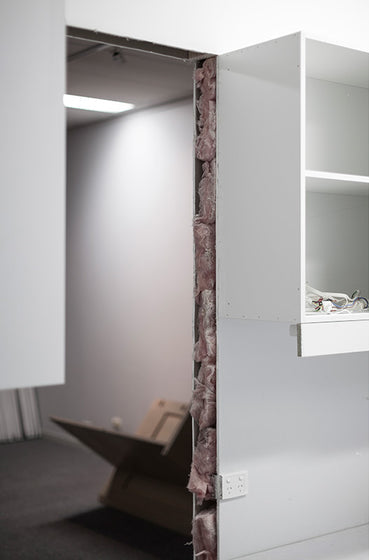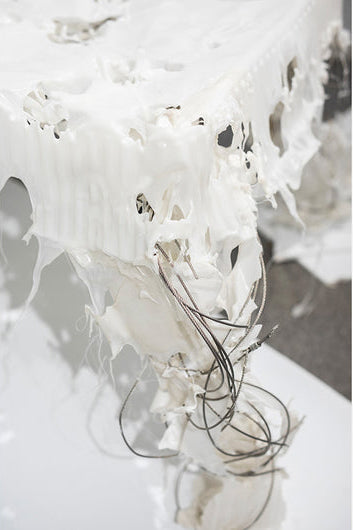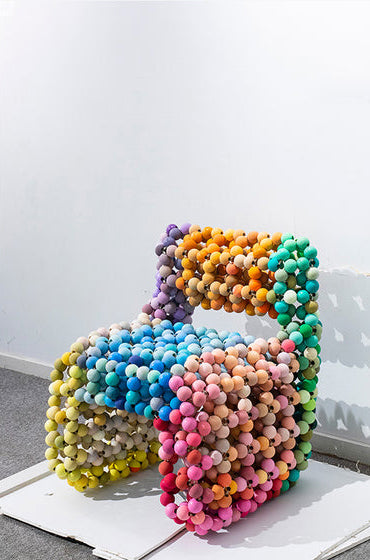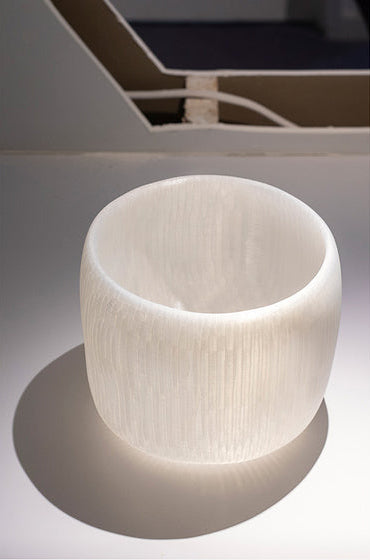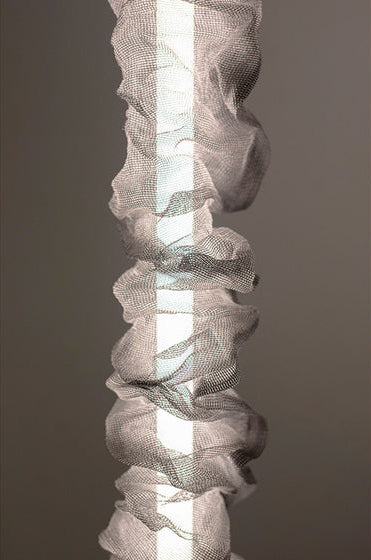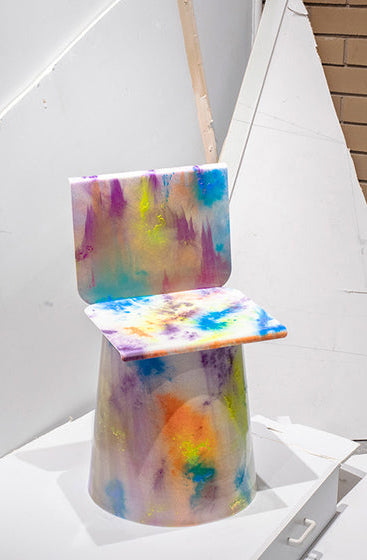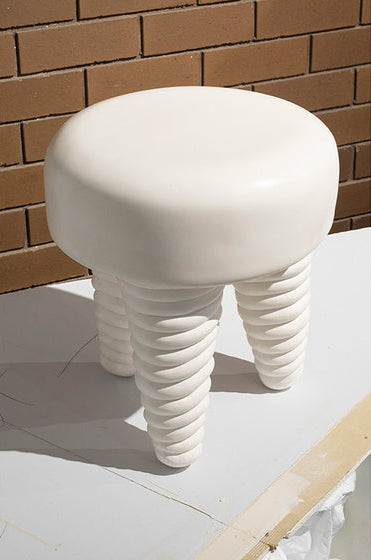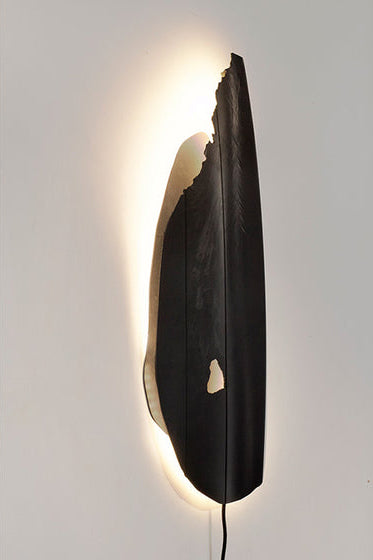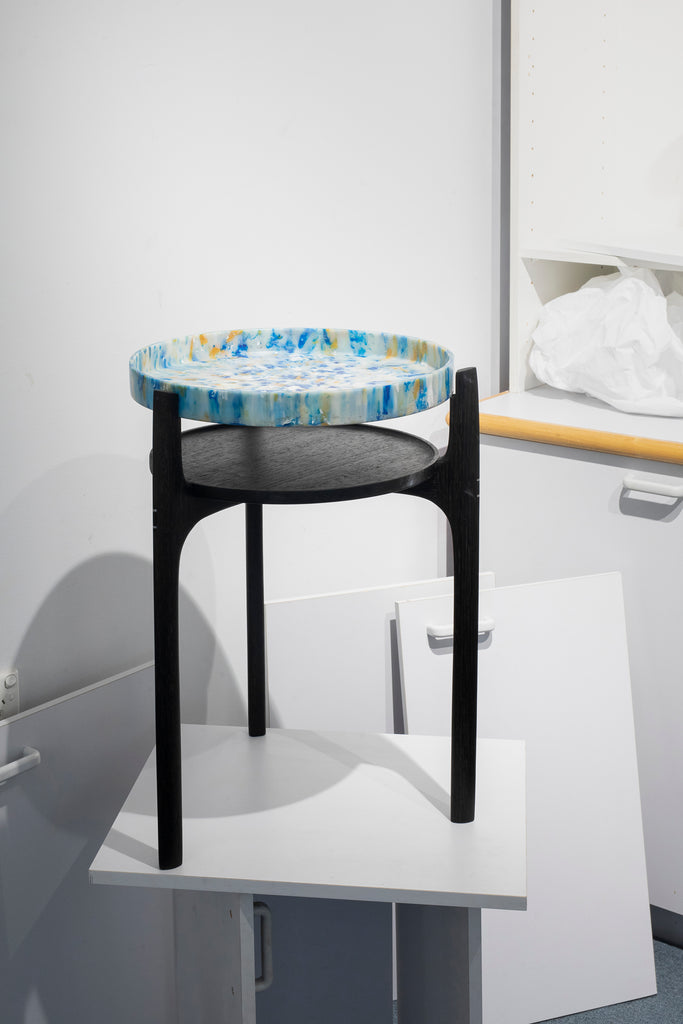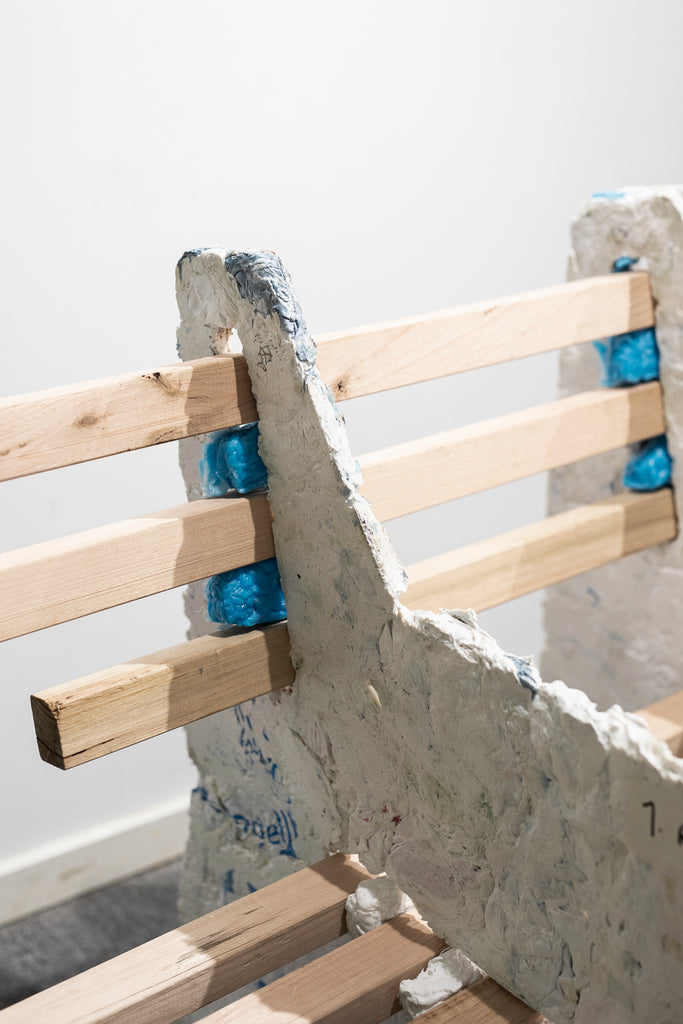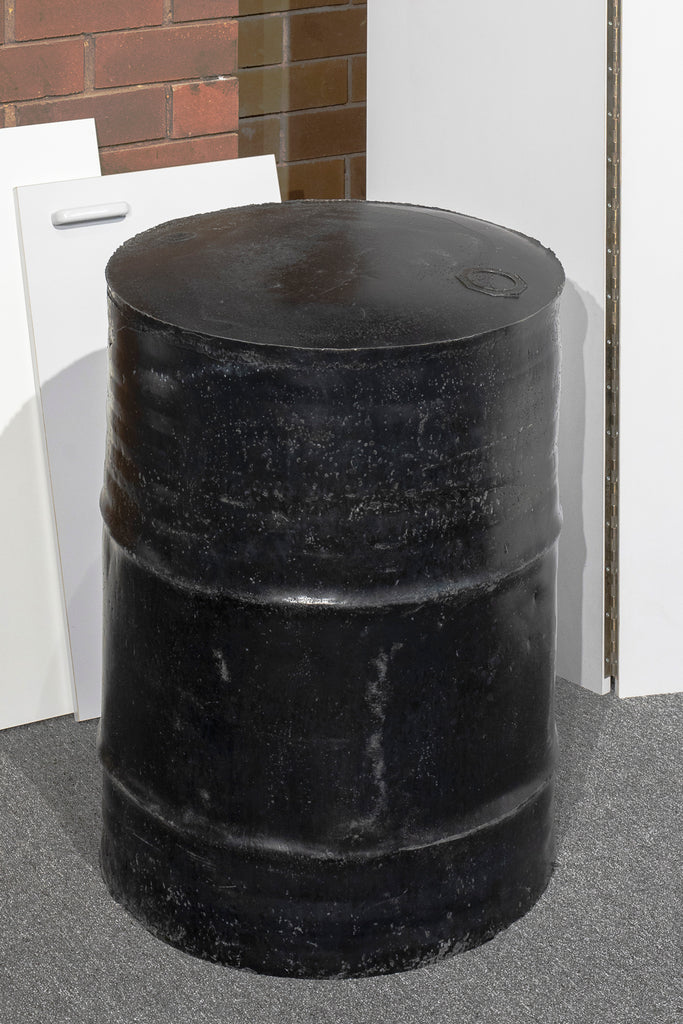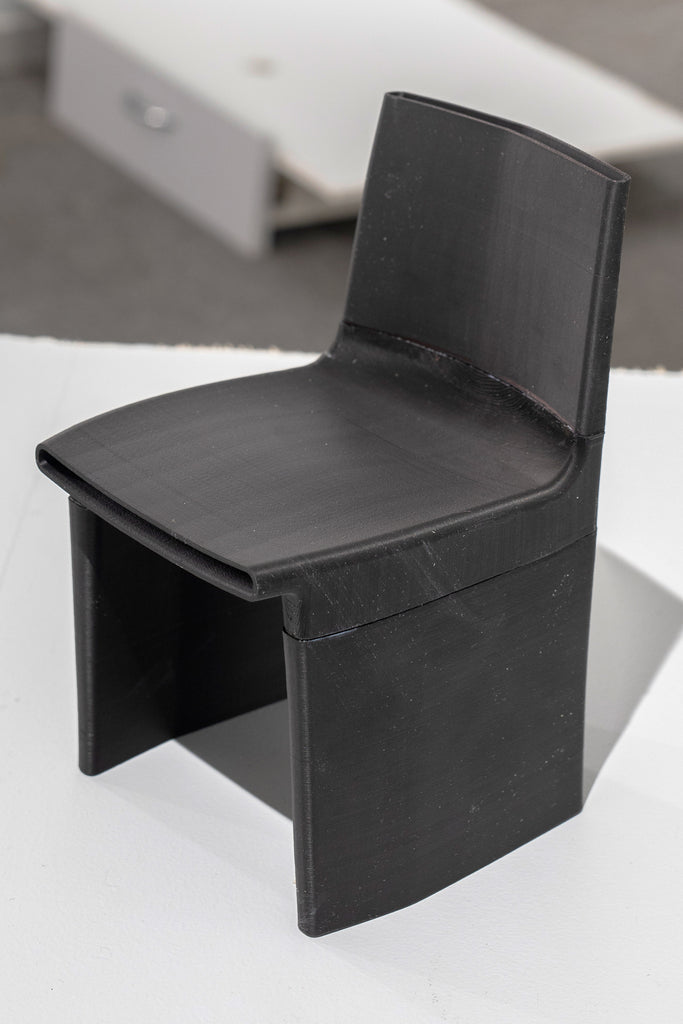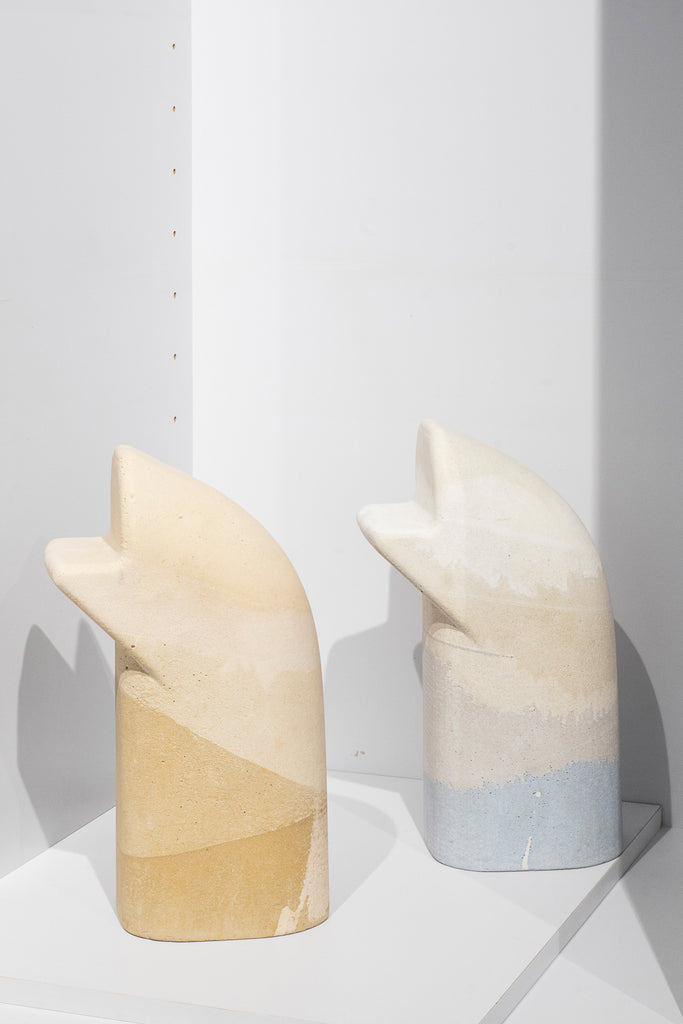Plasticity
2018
Bringing together leading creatives from art and design practices, furniture and product design. The alt.material collective exhibition titled ‘Plasticity’ reflected on both the material and its latent properties. Housed within an empty office building awaiting development, a series of openings were cut in the walls to connect four rooms together, creating the gallery space. Existing materials were repurposed for plinths and backdrops to display the pieces within the exhibition.
All pieces were auctioned via dedicated Instagram page @alt.material with proceeds given to the Australian Marine Conservation Society and the Matthew Harding Family Support Fund.
Photographer: Dylan Lark & Tony Gorsevski
Graphic Designer: Louie Quilao
Exhibition Space / Studio Edwards
Cut outs were made to the existing office partition walls to create connection between rooms for the exhibition
Drip / Ben Edwards
Melted plastic & stainless steel cable
Layer light / Adam Cornish
A practical system-based approach to repurposing a common and abundant waste material. Five small tapered rings are water jet cut from glass off-cuts collected form the glazier cutting process. The abrasive garnet used for water jet cutting creates an elegant, natural diffused finish. Float Glass 10mm & Grey Float Glass 10mm
Lump side table / Michael Gittings
Built from excess readily available recycled Low Density Polyethylene (plastic bags), Lumps grotesque appearance reflects the excesses and wastage of our current plastic manufacturing cycle. Materiality: Low Density Polyethylene (LDPE)
Golf! / Jake Rollins
Golf harnesses simple geometry and a litter item to make a functional object without ‘using up’ a material to do so. Approximately 900,000,000 golf balls are made every year, yet they are notoriously difficult to recycle. Struck by the hidden beauty inside each ball, the designer has paired this material with his own weaving technique to express the beauty often found in repetition and colour, both abundant when dealing with plastic waste items. Materiality (rubber)
A bin called Chuck / Liane Rossler
I have been investigating bioplastics and alternative materials for the last 12 years, so it was a wonderful opportunity to create something for the Plasticity exhibition. ‘A bin called Chuck’ is designed to collect paper, plastics or glass for recycling and can then be turned upside down to put your feet up once you’re finished. Twice as useful. Materiality (Bioplastic - a renewable and biodegradable material derived from corn and soy starch and 35% recycled wood)
Melt pendant / Dylan Morgan
Discarded milk bottles are first cut into small pieces, before being melted and processed through an extruder. The plastic can then be formed over a rod, and once cooled, the rod can be removed, leaving behind a translucent new form. LED strip lights are then inserted into the cavity. Unwanted material is melted and extruded, and formed into useable objects, which could be re-melted and re-formed. Designing for obsolescence is a way to respond to consumption, and striving for plasticity allows us to do it. Materiality (HDPE plastic -recycled milk bottles & Copper)
Chiaroscuro / Scott Lewis & Dean Gaylor
20 Prototype sleeves were produced with a hand applied resin based paste. A 50mm tube was used as a jig to form the substrate. The “inherent makers hand” created a random yet considered ruffled effect. The physical form coupled with varying levels of resin paste formed its own imperfect qualities. As the material dried and was then removed, a new form was randomly created. The tactility of the material made the design process was very hands on and easily manipulated. Removing the form and fitting it to the light source produced its own light refraction and overall aesthetic. Materials (Fluorescent light source, Polyester Textile with hand applied resin application & Non pile fabric Soil resistant treatment)
Lambda (λ) chair / Adam Goodrum & Patryk Koca
Lambda Chair is named after its font like form of the Greek letter and the connotation to calculated growth – the chair is built layer by layer guided by a set of dynamic equations. Lambda is made from recycled ABS in response to surplus plastic waste which can be challenging to use effectively in industrial processes. With the help of UTS Advanced Fabrication Workshop and Protospace we utilised their innovative resources to use recycled waste plastic in the large scale robotic 3d printing process. Additive manufacturing is a natural choice when it comes to creating experimental, yet functional one-off pieces which cannot be replicated in other processes. Materiality (Recycled PLA Plastic)
HT PC / Dowel Jones
Powder coating is widely known to create consistent and uniform finishes on metal substrates. Through the application of a polymer powder and conventionally a powder coating gun, powder coat polymer is sprayed onto the metal surface and applied electrostatically, then placed within an oven to allow the polymer to flow and form a skin. For HT PC, the powder coating gun is removed, and is replaced with human intervention. Each colour is hand thrown onto the metal surface and heated between colours, creating an amalgamation of colour and forming a durable outer surface. Materiality (Steel, Aluminum, Powder coat Polymer)
Whippy / Cordon Sal
Inspired by the process of piping deserts, Whippy is playful, exploring the idea of plasticity. In the material world, plasticity is synonymous with malleability, the flexibility to become almost any form. While this is the case for plastic as a material, plastic products tend to be modular, precise and defined, a typical by-product of design requirements for mass production. Our aim was to counter this machined, mass production view, instead exploring form based on the inherent qualities of plasticity, and the material’s malleability. By extruding thick beads of plaster from a handheld extruder, we improvised the stool’s leg form, letting gravity and material viscosity slump the material into its final resting state. The stools seat top shares culinary influence and is constructed by “icing” plaster onto a base form. We ask our audience to ‘feel’ the visual form before interacting with the object through touch. The tactile stool is immediately familiar and satisfying, since the form is directly representative of the tactile hand processes and malleable materials utilised in it’s creation. Materiality (Water Based Acrylic Polymer, Gypsum, Fibreglass, Reclaimed foam, Wax)
Plastic crash / Jonathan Ben-Tovim
Plastic Crash is an ongoing series of work that re-purposes sections of discarded car panels. The panels are sourced from the industrial area of Fawkner, which is also the suburb of Jonathan’s studio. The Crash series is about taking a surplus material usually associated with disaster, and giving it a new meaning. For the Plastic Crash light, the panel is transformed into an ancient looking artefact, somewhat representing a flint stone or arrow head. It aims to remind the viewer that the artefacts that we will leave behind for future societies to uncover will most likely be the wreckage of our current consumer culture. Materiality (Discarded plastic car bumper, LED lighting, Steel)
Tip top / James Walsh
Tip Top explores the potential of slumping High Density polyethylene, while also aiming to retain the physical form that the material had originally been moulded into. By collecting broken and discarded milk crates and bread baskets found in local hard rubbish collections, James has developed a side table that looks to give new life to a ubiquitous commercial object. Materials (HDPE)
Hull Lounge (first plywood frame prototype) / Tom Fereday
The Hull lounge addresses the context of plasticity through material manipulation. Under normal circumstances plywood is an extremely rigid flat material. Through use of digital CNC machining and intelligent use of the kerfing process the Hull lounge is able to manipulate plywood to form complex compound curvature without the use of any tooling or adhesives allowing for a single shell of the lounge to be constructed entirely from a single sheet of plywood. The Hull lounge responds to the brief plasticity by manipulating a conventional material for the means of a positive outcome, to create a sustainable construction process that does not compromise on complexity of form. Materiality (plywood)
Immutable / Adam Markowitz and Apple Huang
Shredded recylced plastic is placed into an oven and heated to 180 degrees Once heated the molten plastic is removed and placed into a mold within a large screw press. The timber components are cut out through a combination of CNC and hand-shaping. Mortises are cut with a handheld router and custom jig, while the tenons are cut on the table saw.These are fine tuned to fit by hand using chisels and hand planes. Pieces are shaped through a combination of machinery and hand shaping before being assembled. The blonde Tasmanian Oak is darkened using the traditional technique of ebonising (a blend of white vinegar and steel wool which reacts with the tannins in the timber to turn it black). Materiality (Ebonised Tasmanian Oak, Plastic formed from fused HDPE recycled plastic bottles -Milk bottles, Shampoo Bottles, Hand Soap).
Divided layers / Andrew Simpson
The design looks at using the frozen fluidity of thermoplastics to provide a structural bridge and ad rigidity to the simple iconic chair profile. The design was hand drawn, cad molded and then produced as a low resolution prototype for ergonomic testing before producing the mold and production pieces. Materiality (recycled plastic and re claimed timber)
Heavy / Ash Allen
Most plastics are derived from oil. Most plastics are used to make these lightweight, thin-walled, functional objects. They are made by highly automated machines in high volume, and used by us for an instant. We consume them because they are so cheap and convenient. The used plastic pallets were first cut into small fist-sized pieces on a bandsaw. These pieces were then granulated into small pellets. These pellets were then gradually poured and melted, layer by layer, over the course of a week, in a 200L drum in an oven at 195°C. Materiality (100% recycled polypropylene from 18 used plastic pallets. No bio-resin)
1-3D-C / Chris Connell
This chair explores plasticity, and its ability to be reshaped or molded and the quality of these new forms. The idea is to provide a product, in this case a chair, through the means of 3D printing. With 3D printing technology and the speed of production improving, this method eliminates costly molds and tools required in other plastic production. The 3D printing method also allows the production of items on a need basis in turn reducing storage and holding costs. Using recycled plastics and or similar mediums makes for a more sustainable and reusable product. Furthermore, ‘Chair’ CAD files can be sent to any destination in the world that facilitates 3D printing. This flexibility of production means that single or multiple chairs can be produced at the desired location minimizing transport costs, and delivery times. Materiality (PA 12 POLYMIDE)
Bag-bag / Geoff Nees & Matilda Rutherford
Transforming the conventional plastic shopper into a larger, more resilient, longterm solution. Bag-Bag is a bag made from bags. Materiality (Black LDPE plastic)
Loch Ness - Cold Warm Earth / Maddie Sharrock
Designed as part of 0/100 degrees Celsius, a collaborative work between photographer Brooke Holmes.Through traversing the relationship of polar opposites by blurring the lines of the dissimilar and familiar this work creates a middle ground for these temperatures to meet. The work engages with intimacy through the entwinning of objects. The process and materiality engages with plastic. CNC routed polystyrene moulds are then poured with layered cement colours. Materiality (polymer based cement)
Thermoplastic / Mitchell Eaton and Nancy Ji
Low-Density Polyethylene (LDPE) is a thermoplastic, meaning it becomes plastic when heated and solidifies when cool. It also has a relatively low melting point at ~110oC and it most commonly found as plastic bags. When we found out multiple layers could be fused together with a domestic iron to form a sturdy, waterproof sewable fabric with a rich texture we knew we had to experiment with this amazing material. The immediate parallel is with leather, and so we wanted to make bags and a jacket to play off this. A message of recycling and elevating humble materials through craft is inherent in each piece. The first bag is the most overt with its image of discarded bags in the ocean. The second bag offers the alternative with a more subtle message, ‘Recycle’ is spelled out in a morse code pattern across its surface, becoming more apparent as the bag deforms in use. Materiality (Fused LDPE Plastic Bags)
Confetti Side Table / GibsonKarlo for DesignByThem
The colourful recycled plastic bases are made of industrial waste that is re-granulated and put through a rotary mold. The material is then heated and spun until it melts into one form. The result is a component that is highly durable and visually bold. Materials (100% recycled plastic with powder coated stainless steel top).
Slow design / Ross Didier
“… the conception of life as a happy thing, as a festival … but the high value put upon every minute of time, the idea of hurry-hurry as the most important objective of living, is unquestionably the most dangerous enemy of joy.” Hermann Hesse Fluid ideation beyond the constraints of commercialisation, function or trend. My design takes the ‘space’ out of the formula and only deals with the ‘time’. Materiality (steel, wood, earth)
Clay bottles / Paul Marcus Fuog, Uriah Gray, Will Neill, Leanne Gu, Jake Bonin (U-P)
A series of six temporary sculptures created by covering and transforming discarded plastic bottles with clay. We wanted to explore the ironic permanence of synthetic disposal plastic bottles by trapping them within natural clay. These temporary sculptures were destroyed and now only exist through this single photograph. Materiality (clay, plastic bottle)
"5 minutes with Ben Edwards ahead of Plasticity
Not afraid to break the traditional boundaries of a designer, Ben Edwards of Studio Edwards is in the midst of organising a new design program – alt. material – we chat with him ahead of the first exhibition, Plasticity."
"The ambition for the collective: To be experimental, pushing design thinking beyond mere marketability and addressing pressing issues of consumption, functionality and new materialities."
"The classical theory of plasticity grew out of the study of metals in the late nineteenth century. It is concerned with materials which initially deform elastically, but which deform plastically upon reaching a yield stress"
Exhibiting Designers
Sponsors
More Exhibitions



